 In two previous posts, one at the end of 2019 and one in July 2021, we looked at moves around the world to introduce a four-day working week, with no increase in hours on the days worked and no reduction in weekly pay. Firms would gain if increased worker energy and motivation resulted in a gain in output. They would also gain if fewer hours resulted in lower costs.
In two previous posts, one at the end of 2019 and one in July 2021, we looked at moves around the world to introduce a four-day working week, with no increase in hours on the days worked and no reduction in weekly pay. Firms would gain if increased worker energy and motivation resulted in a gain in output. They would also gain if fewer hours resulted in lower costs.
Workers would be likely to gain from less stress and burnout and a better work–life balance. What is more, firms’ and workers’ carbon footprint could be reduced as less time was spent at work and in commuting.
If the same output could be produced with fewer hours worked, this would represent an increase in labour productivity measured in output per hour.
The UK’s poor productivity record since 2008
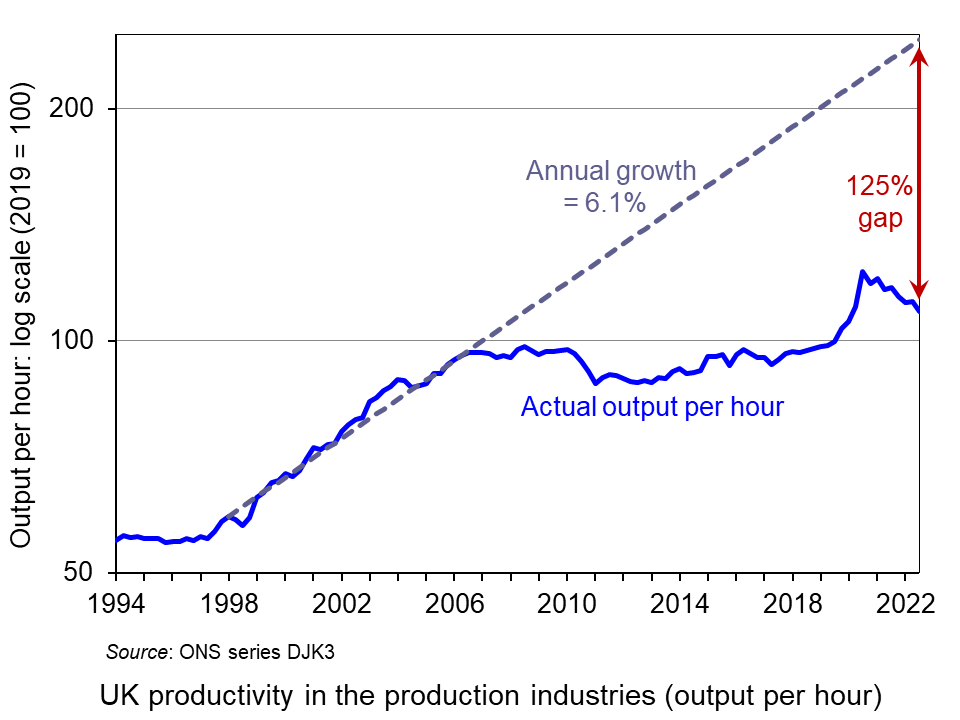 Since the financial crisis of 2007–8, the growth in UK productivity has been sluggish. This is illustrated in the chart, which looks at the production industries: i.e. it excludes services, where average productivity growth tends to be slower. (Click here for a PowerPoint of the chart.)
Since the financial crisis of 2007–8, the growth in UK productivity has been sluggish. This is illustrated in the chart, which looks at the production industries: i.e. it excludes services, where average productivity growth tends to be slower. (Click here for a PowerPoint of the chart.)
Prior to the crisis, from 1998 to 2007, UK productivity in the production industries grew at an annual rate of 6.1%. From 2007 to the start of the pandemic in 2020, the average annual productivity growth rate in these industries was a mere 0.5%.
It grew rapidly for a short time at the start of the pandemic, but this was because many businesses temporarily shut down or went to part-time working, and many of these temporary job cuts were low-wage/low productivity jobs. If you take services, the effect was even stronger as sectors such as hospitality, leisure and retail were particularly affected and labour productivity in these sectors tends to be low. As industries opened up and took on more workers, so average productivity fell back. In the four quarters to 2022 Q3 (the latest data available), productivity in the production industries fell by 6.8%.
If you project the average productivity growth rate from 1998 to 2007 of 6.1% forwards (see grey dashed line), then by 2022 Q3, output per hour in the production industries would have been 21/4 times (125%) higher than it actually was. This is a huge productivity gap.
 Productivity in the UK is lower than in many other competitor countries. According to the ONS, output per hour in the UK in 2021 was $59.14 in the UK. This compares with an average of $64.93 for the G7 countries, $66.75 in France, £68.30 in Germany, $74.84 in the USA, $84.46 in Norway and $128.21 in Ireland. It is lower, however, in Italy ($54.59), Canada ($53.97) and Japan ($47.28).
Productivity in the UK is lower than in many other competitor countries. According to the ONS, output per hour in the UK in 2021 was $59.14 in the UK. This compares with an average of $64.93 for the G7 countries, $66.75 in France, £68.30 in Germany, $74.84 in the USA, $84.46 in Norway and $128.21 in Ireland. It is lower, however, in Italy ($54.59), Canada ($53.97) and Japan ($47.28).
As we saw in the blog, The UK’s poor productivity record, low UK productivity is caused by a number of factors, not least the lack of investment in physical capital, both by private companies and in public infrastructure, and the lack of investment in training. Other factors include short-termist attitudes of both politicians and management and generally poor management practices. But one cause is the poor motivation of many workers and the feeling of being overworked. One solution to this is the four-day week.
Latest evidence on the four-day week
Results have just been released of a pilot programme involving 61 companies and non-profit organisations in the UK and nearly 3000 workers. They took part in a six-month trial of a four-day week, with no increase in hours on the days worked and no loss in pay for employees – in other words, 100% of the pay for 80% of the time. The trial was a success, with 91% of organisations planning to continue with the four-day week and a further 4% leaning towards doing so.
 The model adopted varied across companies, depending on what was seen as most suitable for them. Some gave everyone Friday off; others let staff choose which day to have off; others let staff work 80% of the hours on a flexible basis.
The model adopted varied across companies, depending on what was seen as most suitable for them. Some gave everyone Friday off; others let staff choose which day to have off; others let staff work 80% of the hours on a flexible basis.
There was little difference in outcomes across different types of businesses. Compared with the same period last year, revenues rose by an average of 35%; sick days fell by two-thirds and 57% fewer staff left the firms. There were significant increases in well-being, with 39% saying they were less stressed, 40% that they were sleeping better; 75% that they had reduced levels of burnout and 54% that it was easier to achieve a good work–life balance. There were also positive environmental outcomes, with average commuting time falling by half an hour per week.
There is growing pressure around the world for employers to move to a four-day week and this pilot provides evidence that it significantly increases productivity and well-being.
Articles
- Results from world’s largest 4 day week trial bring good news for the future of work
4 Day Week Global, Charlotte Lockhart (21/2/23)
- Four-day week: ‘major breakthrough’ as most UK firms in trial extend changes
The Guardian, Heather Stewart (21/2/23)
- Senedd committee backs four-day working week trial in Wales
The Guardian, Steven Morris (24/1/23)
- ‘Major breakthrough’: Most firms say they’ll stick with a four-day working week after successful trial
Sky News, Alice Porter (21/2/23)
- Major four-day week trial shows most companies see massive staff mental health benefits and profit increase
Independent, Anna Wise (21/2/23)
- Four-day week: Which countries have embraced it and how’s it going so far?
euronews, Josephine Joly and Luke Hurst (23/2/23)
- Firms stick to four-day week after trial ends
BBC News, Simon Read, Lucy Hooker & Emma Simpson (21/2/23)
- The climate benefits of a four-day workweek
BBC Future Planet, Giada Ferraglioni and Sergio Colombo (21/2/23)
- Four-day working week: why UK businesses and workers will continue with new work pattern, plus pros and cons
National World, Rochelle Barrand (22/2/23)
- Most companies in UK four-day week trial to continue with flexible working
Financial Times, Daniel Thomas and Emma Jacobs (21/2/23)
- The pros and cons of a four-day working week
Financial Times, Editorial (13/2/23)
- Explaining the UK’s productivity slowdown: Views of leading economists
VoxEU, Ethan Ilzetzki (11/3/20)
- Why the promised fourth industrial revolution hasn’t happened yet
The Conversation, Richard Markoff and Ralf Seifert (27/2/23)
Questions
- What are the possible advantages of moving to a four-day week?
- What are the possible disadvantages of moving to a four-day week?
- What types of companies or organisations are (a) most likely, (b) least likely to gain from a four-day week?
- Why has the UK’s productivity growth been lower than that of many of its major competitors?
- Why, if you use a log scale on the vertical axis, is a constant rate of growth shown as a straight line? What would a constant rate of growth line look like if you used a normal arithmetical scale for the vertical axis?
- Find out what is meant by the ‘fourth industrial revolution’. Does this hold out the hope of significant productivity improvements in the near future? (See, for example, last link above.)
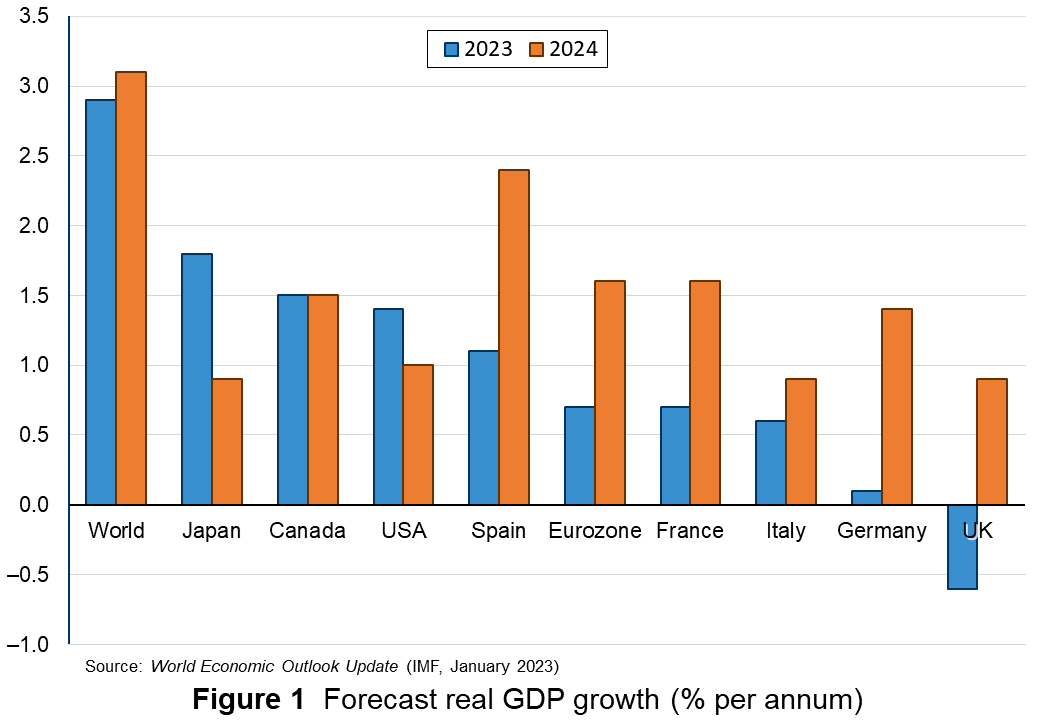 In its latest World Economic Outlook update, the IMF forecasts that the UK in 2023 will be the worst performing economy in the G7. Unlike all the other countries and regions in the report, only the UK economy is set to shrink. UK real GDP is forecast to fall by 0.6% in 2023 (see Figure 1: click here for a PowerPoint). In the USA it is forecast to rise by 1.4%, in Germany by 0.1%, in France by 0.7% and in Japan by 1.8%. GDP in advanced countries as a whole is forecast to grow by 1.2%, while world output is forecast to grow by 2.9%. Developing countries are forecast to grow by 4.0%, with China and India forecast to grow by 5.2% and 6.1%, respectively. And things are not forecast to be a lot better for the UK in 2024, with growth of 0.9% – bottom equal with Japan and Italy.
In its latest World Economic Outlook update, the IMF forecasts that the UK in 2023 will be the worst performing economy in the G7. Unlike all the other countries and regions in the report, only the UK economy is set to shrink. UK real GDP is forecast to fall by 0.6% in 2023 (see Figure 1: click here for a PowerPoint). In the USA it is forecast to rise by 1.4%, in Germany by 0.1%, in France by 0.7% and in Japan by 1.8%. GDP in advanced countries as a whole is forecast to grow by 1.2%, while world output is forecast to grow by 2.9%. Developing countries are forecast to grow by 4.0%, with China and India forecast to grow by 5.2% and 6.1%, respectively. And things are not forecast to be a lot better for the UK in 2024, with growth of 0.9% – bottom equal with Japan and Italy.
Low projected growth in the UK in part reflects the tighter fiscal and monetary policies being implemented to curb inflation, which is slow to fall thanks to tight labour markets and persistently higher energy prices. The UK is particularly exposed to high wholesale gas prices, with a larger share of its energy coming from natural gas than most countries.
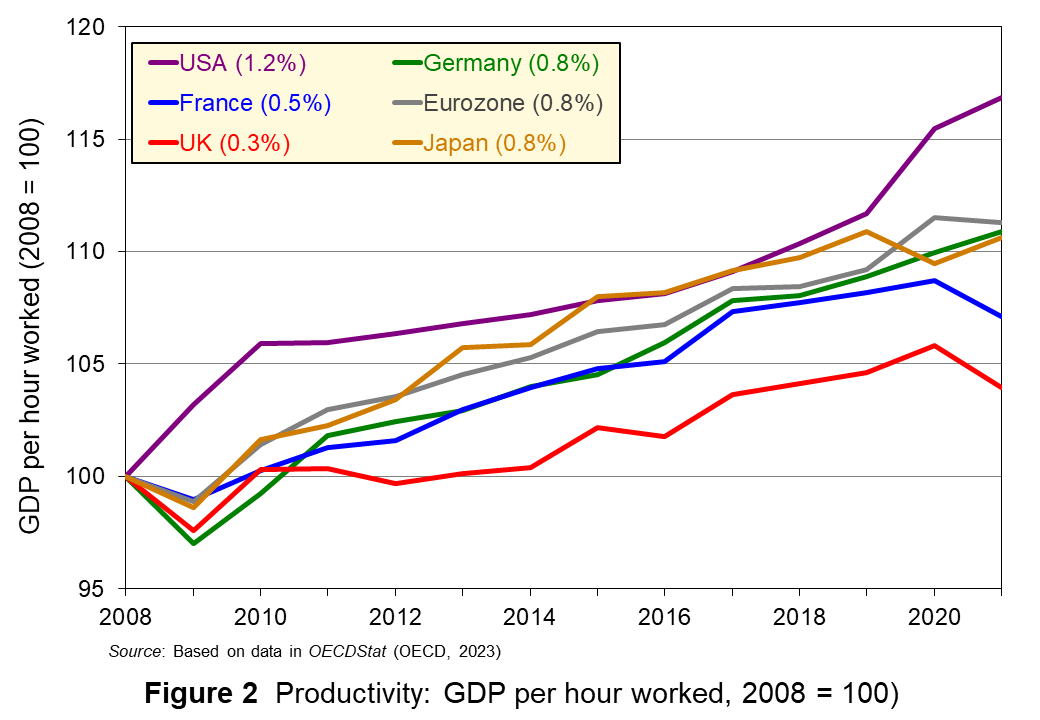 But the UK’s lower forecast growth relative to other countries reflects a longer-term problem in the UK and that is the slow rate of productivity growth. This is illustrated in Figure 2, which shows output (GDP) per hour worked in major economies, indexed at 100 in 2008 (click here for a PowerPoint). As you can see, the growth in productivity in the UK has lagged behind that of the other economies. The average annual percentage growth in productivity is shown next to each country. The UK’s growth in productivity since 2008 has been a mere 0.3% per annum.
But the UK’s lower forecast growth relative to other countries reflects a longer-term problem in the UK and that is the slow rate of productivity growth. This is illustrated in Figure 2, which shows output (GDP) per hour worked in major economies, indexed at 100 in 2008 (click here for a PowerPoint). As you can see, the growth in productivity in the UK has lagged behind that of the other economies. The average annual percentage growth in productivity is shown next to each country. The UK’s growth in productivity since 2008 has been a mere 0.3% per annum.
Causes of low productivity/low productivity growth
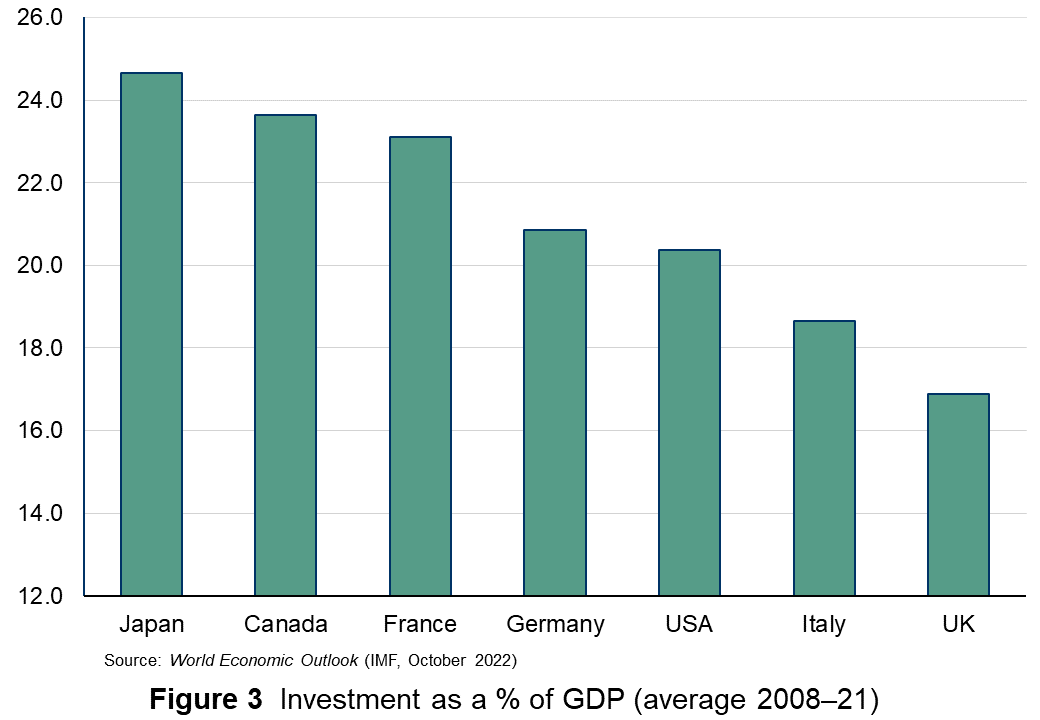 A major cause of low productivity growth is low levels of investment in physical capital. Figure 3 shows investment (gross capital formation) as a percentage of GDP for the G7 countries from the 2007–8 financial crisis to the year before the pandemic (click here for a PowerPoint). As you can see, the UK performs the worst of the seven countries.
A major cause of low productivity growth is low levels of investment in physical capital. Figure 3 shows investment (gross capital formation) as a percentage of GDP for the G7 countries from the 2007–8 financial crisis to the year before the pandemic (click here for a PowerPoint). As you can see, the UK performs the worst of the seven countries.
Part of the reason for the low level of private investment is uncertainty. Firms have been discouraged from investing because of a lack of economic growth and fears that this was likely to remain subdued. The problem was compounded by Brexit, with many firms uncertain about their future markets, especially in the EU. COVID affected investment, as it did in all countries, but supply chain problems in the aftermath of COVID have been worse for the UK than many countries. Also, the UK has been particularly exposed to the effects of higher gas prices following the Russian invasion of Ukraine, as a large proportion of electricity is generated from natural gas and natural gas is the major fuel for home heating.
Part of the reason is an environment that is unconducive for investment. Access to finance for investment is more difficult in the UK and more costly than in many countries. The financial system tends to have a short-term focus, with an emphasises on dividends and short-term returns rather than on the long-term gains from investment. This is compounded by physical infrastructure problems with a lack of investment in energy, road and rail and a slow roll out of advances in telecoms.

To help fund investment and drive economic growth, in 2021 the UK government established a government-owned UK Infrastructure Bank. This has access to £22 billion of funds. However, as The Conversation article below points out:
According to a January 2023 report from Westminster’s Public Accounts Committee, 18 months after its launch the bank had only deployed ‘£1 billion of its £22 billion capital to 10 deals’, and had employed just 16 permanent staff ‘against a target of 320’. The committee also said it was ‘not convinced the bank has a strategic view of where it best needs to target its investments’.
Short-termism is dominant in politics, with ministers keen on short-term results in time for the next election, rather than focusing on the long term when they may no longer be in office. When the government is keen to cut taxes and find ways of cutting government expenditure, it is often easier politically to cut capital expenditure rather than current expenditure. The Treasury oversees fiscal policy and its focus tends to be short term. What is needed is a government department where the focus is on the long term.
One problem that has impacted on productivity is the relatively large number of people working for minimum wages or a little above. Low wages discourage firms from making labour-saving investment and thereby increasing labour productivity. It will be interesting to see whether the labour shortages in the UK, resulting from people retiring early post-COVID and EU workers leaving, will encourage firms to make labour-saving investment.
Another issue is company taxation. Until recently, countries have tended to compete corporate taxes down in order to attract inward investment. This was stemmed somewhat by the international agreement at the OECD that Multinational Enterprises (MNEs) will be subject to a minimum 15% corporate tax rate from 2023. The UK is increasing corporation tax from 19% to 25% from April 2023. It remains to be seen what disincentive effect this will have on inward investment. Although the new rate is similar to, or slightly lower, than other major economies, there are some exceptions. Ireland will have a rate of just 15% and is seen as a major alternative to the UK for inward investment, especially with its focus on cheaper green energy. AstraZeneca has just announced that instead of building its new ‘state-of-the-art’ manufacturing plant in England close to its two existing plats in NW England, it will build it in Ireland instead, quoting the UK’s ‘discouraging’ tax rates and price capping for drugs by the NHS.
 And it is not just physical investment that affects productivity, it is the quality of labour. Although a higher proportion of young people go to university (close to 50%) than in many other countries, the nature of the skills sets acquired may not be particularly relevant to employers.
And it is not just physical investment that affects productivity, it is the quality of labour. Although a higher proportion of young people go to university (close to 50%) than in many other countries, the nature of the skills sets acquired may not be particularly relevant to employers.
What is more, relatively few participate in vocational education and training. Only 32% of 18-year olds have had any vocational training. This compares with other countries, such as Austria, Denmark and Switzerland where the figure is over 65%. Also a greater percentage of firms in other countries, such as Germany, employ people on vocational training schemes.
Another aspect of labour quality is the quality of management. Poor management practices in the UK and inadequate management training and incentives have resulted in a productivity gap with other countries. According to research by Bloom, Sadun & Van Reenen (see linked article below, in particular Figure A5) the UK has an especially large productivity gap with the USA compared with other countries and the highest percentage of this gap of any country accounted for by poor management.
Solutions
Increasing productivity requires a long-term approach by both business and government. Policy should be consistent, with no ‘chopping and changing’. The more that policy is changed, the less certain will business be and the more cautious about investing.
As far a government investment is concerned, capital investment needs to be maintained at a high level if significant improvements are to be made in the infrastructure necessary to support increased growth rates. As far as private investment is concerned, there needs to be a focus on incentives and finance. If education and training are to drive productivity improvements, then there needs to be a focus on the acquisition of transferable skills.
Such policies are not difficult to identify. Carrying them out in a political environment focused on the short term is much more difficult.
Podcasts
Articles
- UK to perform worst of major economies in 2023, says IMF – here’s how to achieve long-term growth
The Conversation, Michael Kitson (2/2/23)
- The UK economy has recovered from doom and recession before – and it can do so again: the Economy 2030 Inquiry
Resolution Foundation, Centre for Economic Performance and Nuffield Foundation, Krishan Shah (7/2/23)
- Minding the (productivity and income) gaps: the Economy 2030 Inquiry
Resolution Foundation, Centre for Economic Performance and Nuffield Foundation, Krishan Shah and Gregory Thwaites (3/2/23)
- How to fix the British economy
Financial Times, Tim Harford (3/2/23)
- Is the IMF right about the UK economy?
Financial Times, Chris Giles (31/1/23)
- Why is UK Productivity Low and How Can It Improve?
The National Institute of Economic and Social Research (NIESR), Issam Samiri and Stephen Millard (26/9/22)
- Britain’s productivity puzzle
LSE British Politics and Policy, Ben Clift and Sean McDaniel (7/9/22)
- Why is the UK So Unproductive Compared to Germany?
Agency Central (26/8/20)
- Smarter taxes could ease UK productivity crisis
Reuters, Francesco Guerrera (9/1/23)
- Diagnosing the UK productivity slowdown: which sectors matter and why?
The Bennett Institute for Public Policy, University of Cambridge, Lucy Hampton (20/1/23)
- Management as a Technology?
National Bureau of Economic Research, Nicholas Bloom, Raffaella Sadun & John Van Reenen (October 2017)
- Take AstraZeneca’s warning seriously. The UK is missing out in life sciences
The Guardian, Nils Pratley (9/2/23)
Data
Questions
- What features of the UK economic and political environment help to explain its poor productivity growth record?
- What are the arguments for and against making higher education more vocational?
- Find out what policies have been adopted in a country of your choice to improve productivity. Are there any lessons that the UK could learn from this experience?
- How could the UK attract more inward foreign direct investment? Would the outcome be wholly desirable?
- What is the relationship between inequality and labour productivity?
- What are the arguments for and against encouraging more immigration in the current economic environment?
- Could smarter taxes ease the UK’s productivity crisis?
 When building supply and demand models, the assumption is usually made that both producers and consumers act in a ‘rational’ way to achieve the best possible outcomes. As far as producers are concerned, this would mean attempting to maximise profit. As far as consumers are concerned, it would mean attempting to achieve the highest satisfaction (utility) from their limited budget. This involves a cost–benefit calculation, where people weigh up the costs and benefits of allocating their money between different goods and services.
When building supply and demand models, the assumption is usually made that both producers and consumers act in a ‘rational’ way to achieve the best possible outcomes. As far as producers are concerned, this would mean attempting to maximise profit. As far as consumers are concerned, it would mean attempting to achieve the highest satisfaction (utility) from their limited budget. This involves a cost–benefit calculation, where people weigh up the costs and benefits of allocating their money between different goods and services.
For consumers to act rationally, the following assumptions are made:
- Consumer choices are made independently. Their individual choices and preferences are not influenced by other people’s, nor do their choices and preferences impact on other people’s choices.
- The consumer’s preferences are consistent and fixed.
- Consumers have full information about the products available and alternatives to them.
- Given the information they have and the preferences they hold, consumers will then make an optimal choice.
 Black Friday can be seen as a perfect occasion for consumers to get their hands on a bargain. It is an opportunity to fulfil a rational need, for example if you were needing to replace a household appliance but were waiting until there was a good deal before committing to a purchase.
Black Friday can be seen as a perfect occasion for consumers to get their hands on a bargain. It is an opportunity to fulfil a rational need, for example if you were needing to replace a household appliance but were waiting until there was a good deal before committing to a purchase.
The assumption that people act rationally has been at the forefront of economic theory for decades. However, this has been questioned by the rise in behavioural economics. Rather than assuming that all individuals are ‘rational maximisers’ and conduct a cost–benefit analysis for every decision, behavioural economists mix psychology with economics by focusing on the human. As humans, we do not always behave rationally but, instead, we act under bounded rationality.
As economic agents, we make different decisions depending on our emotional state that differ from the ‘rational choice’ assumption. We are also influenced by our social networks and often make choices that provide us with immediate gratification. Given this, Black Friday can also be viewed as a great opportunity to fall prey to irrational and emotional shopping behaviours.
Black Friday originated in the USA and is the day after Thanksgiving. During this annual shopping holiday, retailers typically offer steep discounts to kick off the holiday season. The Black Friday shopping phenomenon is less than a decade old in the UK but it’s now an established part of the pre-Christmas retail calendar. Between 2010 and 2013, Black Friday gradually built up momentum in the UK. In 2014, Black Friday became the peak pre-Christmas online sales day and many online retailers haven’t looked back.
 Arguably, from a behavioural economist’s perspective, the big problem with Black Friday is that all the reasons consumers possibly have to partake can be largely illusory. Consumers are bombarded with the promise of one-off deals, large discounts, scarce products, and an opportunity to get their holiday shopping done all at once. However, on Black Friday, our rational decision-making faculties are tested, just as stores are trying their hardest to maximise consumers’ mistakes.
Arguably, from a behavioural economist’s perspective, the big problem with Black Friday is that all the reasons consumers possibly have to partake can be largely illusory. Consumers are bombarded with the promise of one-off deals, large discounts, scarce products, and an opportunity to get their holiday shopping done all at once. However, on Black Friday, our rational decision-making faculties are tested, just as stores are trying their hardest to maximise consumers’ mistakes.
There are many ‘behavioural traps’ that consumers often fall into. The following two are most likely to occur on Black Friday:
- Scarcity and loss aversion. Shoppers may fear that they will miss out on the best sales deals available if they don’t buy it now. Retailers commonly spark consumers’ interest by highlighting limited stocks available for a limited time only, which raises the perceived value of these goods. This sense of scarcity can further trigger the need to buy now, increasing the ‘Fear of Missing Out’. Consumers therefore need to ask themselves if they are really missing out if they don’t buy it now? And is the discount worth spending the money today, or is there something else I should be spending it on or saving for?
- Sunk cost fallacy. Once consumers have started to invest, they often struggle to close out investments that prove unprofitable. On Black Friday, customers have already made the initial investment of getting up early, driving to the shops, finding parking and waiting in a queue, before they have purchased anything. Therefore, they will be inclined to buy more than they initially went for. It is important therefore to think about each purchase in isolation.
 This year, however, there is also the added complication of the rising cost of living. Whilst this may deter some consumers from unnecessary, impulse purchases, some consumers are using Black Friday as an opportunity to stock up on expected future purchases, hedging against likely price rises over the coming months.
This year, however, there is also the added complication of the rising cost of living. Whilst this may deter some consumers from unnecessary, impulse purchases, some consumers are using Black Friday as an opportunity to stock up on expected future purchases, hedging against likely price rises over the coming months.
It is thought that more consumers will be looking for a combination of high quality but low price to make sure their purchases are affordable and can last for a long time. According to PwC, many consumers have closely monitored their favourite brands in anticipation that big-ticket electronics, more pricey winter wear or Christmas stocking fillers will be discounted. Consumers are also in search of bargains more than ever given rising inflation. This would suggest a shift in attitude, meaning consumers will be more aware of what they cannot afford rather than giving in to emotional temptation brought on by Black Friday.
Retailers are fully aware of the cognitive biases that surround Black Friday and take full advantage of them. ‘Cyber Monday’ follows right after Black Friday, giving retailers an extra opportunity for them to keep those ‘urgent’ or ‘unmissable’ sales going and increase their revenues.
 Black Friday is one of the biggest shopping days of the year. However, the way retailers approach it is growing increasingly mixed. Stores such as Amazon, Argos, Currys and John Lewis have started offering Black Friday deals much earlier in the month, leading some to refer to the event as ‘Black November’. Other stores, such as M&S and Next, didn’t take part at all this year.
Black Friday is one of the biggest shopping days of the year. However, the way retailers approach it is growing increasingly mixed. Stores such as Amazon, Argos, Currys and John Lewis have started offering Black Friday deals much earlier in the month, leading some to refer to the event as ‘Black November’. Other stores, such as M&S and Next, didn’t take part at all this year.
Ultimately, Consumers can use insights from behavioural economics to empower them to make more rational decisions in such circumstances: ones that better align with their individual budgets. Nevertheless, the Black Friday sales mania can trigger our deepest emotional and cognitive responses that lead to unnecessary spending.
Articles
Video
Questions
- Discuss what is meant by the term ‘rational consumer’. Is it a useful generalisation about the way consumers behave?
- Discuss what is meant by the term ‘rational producer’. Is it a useful generalisation about the way firms behave?
- What is cost–benefit analysis? What is the procedure used in conducting a cost–benefit analysis?
- In addition to scarcity and loss aversion and the sunk cost fallacy, are there any other reasons why consumers may not always act rationally?
- Are people likely to be more ‘rational’ about online Black Friday purchases than in-store ones? Explain.
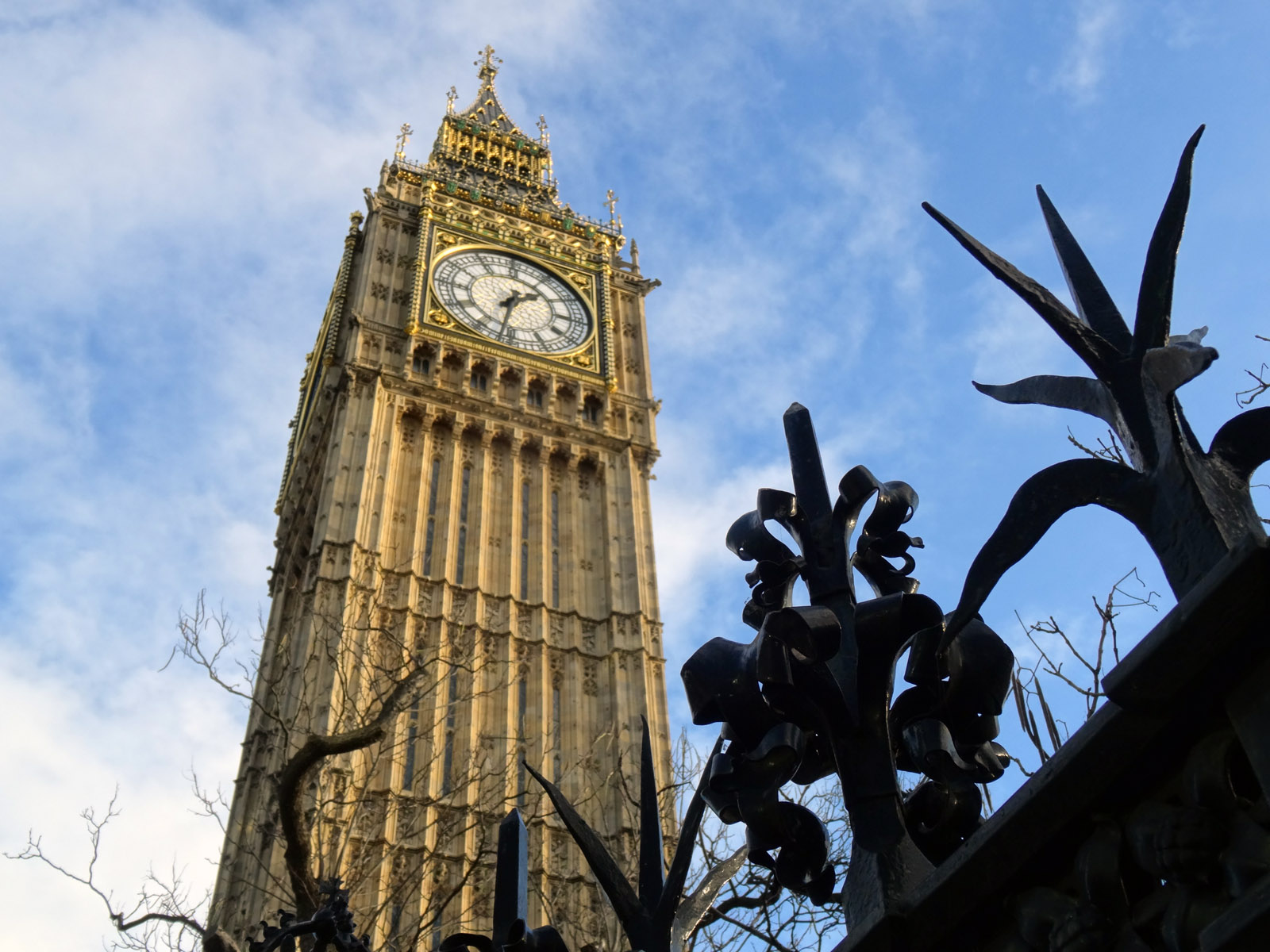 In her bid to become Conservative party leader, Liz Truss promised to make achieving faster economic growth her number-one policy objective. This would involve pursuing market-orientated supply-side policies.
In her bid to become Conservative party leader, Liz Truss promised to make achieving faster economic growth her number-one policy objective. This would involve pursuing market-orientated supply-side policies.
These policies would include lower taxes on individuals to encourage people to work harder and more efficiently, and lower taxes on business to encourage investment. The policy would also involve deregulation, which would again encourage investment, both domestic and inward investment from overseas. These proposals echoed the policies pursued in the 1980s by President Ronald Reagan in the USA and Margaret Thatcher in the UK.
On September 23, the new Chancellor, Kwasi Kwarteng, presented a ‘mini-Budget’ – although the size of the changes made it far from ‘mini’. This, as anticipated, included policies intended to boost growth, including scrapping the 45% top rate of income tax, which is currently paid by people earning over £150 000 (a policy withdrawn on 3 October after massive objections), cutting the basic rate of income tax from 20% to 19%, scrapping the planned rise in corporation tax from 19% to 25%, scrapping the planned rise in national insurance by 1.25 percentage points, a cut in the stamp duty on house purchase and scrapping the limit placed on bankers’ bonuses. In addition, he announced the introduction of an unlimited number of ‘investment zones’ which would have lower business taxes, streamlined planning rules and lower regulation. The policies would be funded largely from extra government borrowing.
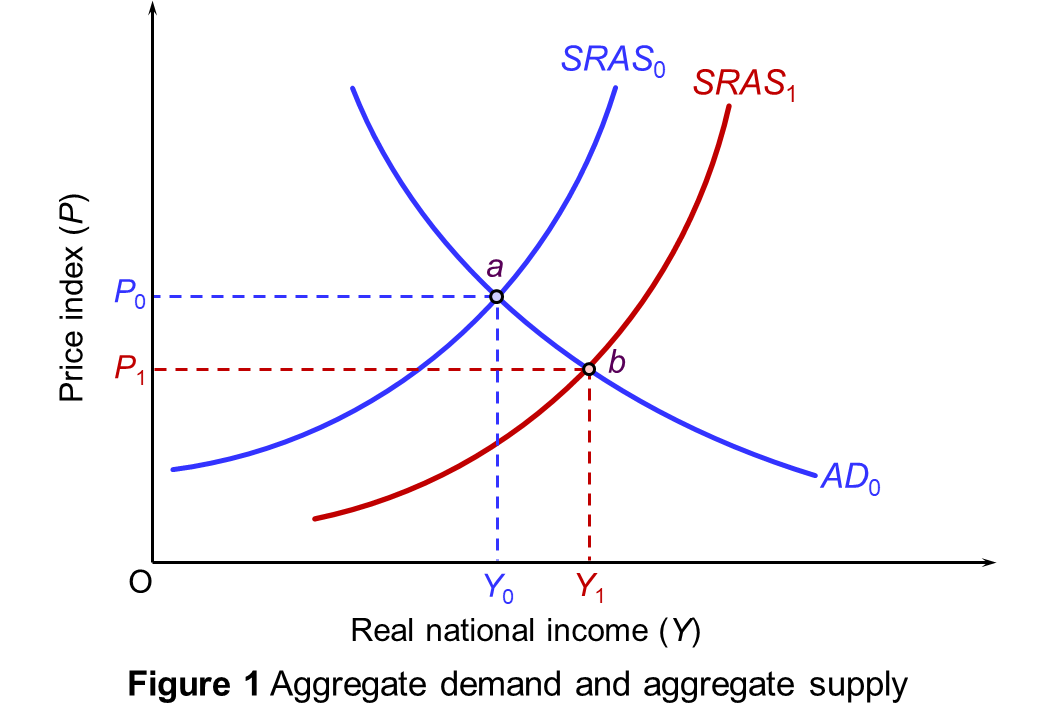 Theoretically, the argument is simple. If people do work harder and firms do invest more, then potential GDP will rise – a rise in aggregate supply. This can be shown on an aggregate demand and supply diagram. If the policy works, the aggregate supply curve will shift to the right. Real GDP will rise and there will be downward pressure on prices. In Figure 1, real GDP will rise from Y0 to Y1 and the price level will fall from P0 to P1. However, things are not as simple as this. Indeed, there are two major problems.
Theoretically, the argument is simple. If people do work harder and firms do invest more, then potential GDP will rise – a rise in aggregate supply. This can be shown on an aggregate demand and supply diagram. If the policy works, the aggregate supply curve will shift to the right. Real GDP will rise and there will be downward pressure on prices. In Figure 1, real GDP will rise from Y0 to Y1 and the price level will fall from P0 to P1. However, things are not as simple as this. Indeed, there are two major problems.
The first concerns whether tax cuts will incentivise people to work harder. The second concerns what happens to aggregate demand. I addition to this, the policies are likely to have a profound effect on income distribution.
Tax cuts and incentives
Cutting the top rate of income tax would have immediately given people at the top of the income scale a rise in post-tax income. This would have created a substitution effect and an income effect. Each extra pound that such people earn would be worth more in post-tax income – 60p rather than 55p. This would provide an incentive for people to substitute work for leisure as work is now more rewarding. This is the substitution effect. On the other hand, with the windfall of extra income, they now would have needed to work less in order to maintain their post-tax income at its previous level. They may well indeed, therefore, have decided to work less and enjoy more leisure. This is the income effect.
With the diminishing marginal utility of income, generally the richer people are, the bigger will be the income effect and the smaller the substitution effect. Thus, cutting the top rate of income tax may well have led to richer people working less. There is no evidence that the substitution effect would be bigger.
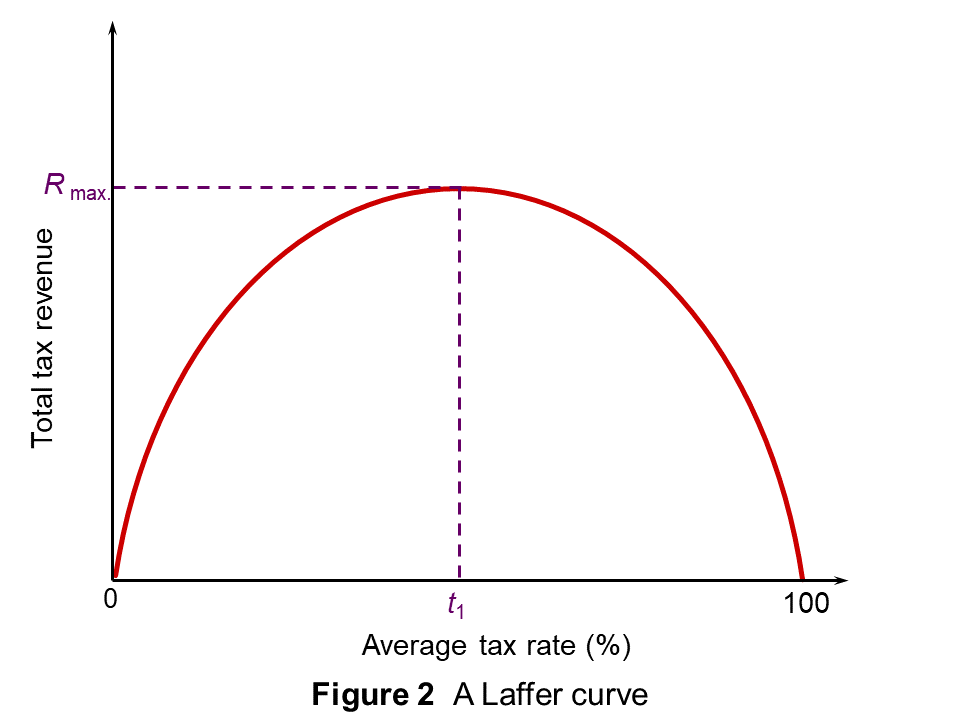 If top rates of income tax are already at a very high level, then cutting then may well encourage more work. After all, there is little incentive to work more if the current rate of tax is over 90%, say. Cutting them to 80% could have a big effect. This was the point made by Art Laffer, one of Ronald Reagan’s advisors. He presented his arguments in terms of the now famous ‘Laffer curve’, shown in Figure 2. This shows the total tax revenue raised at different tax rates.
If top rates of income tax are already at a very high level, then cutting then may well encourage more work. After all, there is little incentive to work more if the current rate of tax is over 90%, say. Cutting them to 80% could have a big effect. This was the point made by Art Laffer, one of Ronald Reagan’s advisors. He presented his arguments in terms of the now famous ‘Laffer curve’, shown in Figure 2. This shows the total tax revenue raised at different tax rates.
If the average tax rate were zero, no revenue would be raised. As the tax rate is raised above zero, tax revenues will increase. The curve will be upward sloping. Eventually, however, the curve will peak (at tax rate t1). Thereafter, tax rates become so high that the resulting fall in output more than offsets the rise in tax rate. When the tax rate reaches 100 per cent, the revenue will once more fall to zero, since no one will bother to work.
If the economy were currently to the right of t1, then cutting taxes would increase revenue as there would be a major substitution effect. However, most commentators argue that the UK economy is to the left of t1 and that cutting the top rate would reduce tax revenues. Analysis by the Office for Budget Responsibility in 2012 suggested that t1 for the top rate of income tax was at around 48% and that cutting the rate below that would reduce tax revenue. Clearly according to this analysis, 40% is considerably below t1.
As far as corporation tax is concerned, the 19% rate is the lowest in the G20 and yet the UK suffers from low rates of both domestic investment and inward direct investment. There is no evidence that raising it somewhat, as previously planned, will cut investment. And as far as individual entrepreneurs are concerned, cutting taxes is likely to have little effect on the desire to invest and expand businesses. The motivation of entrepreneurs is only partly to do with the money. A major motivation is the sense of achievement in building a successful business.
Creating investment zones with lower taxes, no business rates and lower regulations may encourage firms to set up there. But much of this could simply be diverted investment from elsewhere in the country, leaving overall investment little changed.
To assess these questions, the government needs to model the outcomes and draw on evidence from elsewhere. So far this does not seem to have happened. They government did not even present a forecast of the effects of its policies on the public finances, something that the OBR normally presents at Budget time. This was one of the reasons for the collapse in confidence of sterling and gilts (government bonds) in the days following the mini-Budget.
Effects on aggregate demand
 Cutting taxes and financing them from borrowing will expand aggregate demand. In Figure 1, the AD curve will also shift to the right and this will push up prices. Inflation is already a serious problem in the economy and unfunded tax cuts will make it worse. Higher inflation will result in the Bank of England raising interest rates further to curb aggregate demand. But higher interest rates, by raising borrowing costs, are likely to reduce investment, which will have a negative supply-side effect.
Cutting taxes and financing them from borrowing will expand aggregate demand. In Figure 1, the AD curve will also shift to the right and this will push up prices. Inflation is already a serious problem in the economy and unfunded tax cuts will make it worse. Higher inflation will result in the Bank of England raising interest rates further to curb aggregate demand. But higher interest rates, by raising borrowing costs, are likely to reduce investment, which will have a negative supply-side effect.
The problem here is one of timing. Market-orientated supply-side policies, if they work to increase potential GDP, will take time – measured in years rather than months. The rise in aggregate demand will be much quicker and will thus precede the rise in supply. This could therefore effectively kill off the rise in supply as interest rates rise, the exchange rate falls and the economy is pushed towards recession. Indeed, the mini-Budget immediately sparked a run on the pound and the exchange rate fell.
The rising government debt may force the government to make cuts in public expenditure. Rather than cutting current expenditure on things such as nurses, teachers and benefits, it is easier to cut capital expenditure on things such as roads and other infrastructure. But this will have adverse supply-side effects.
Effects on income distribution
 Those advocating market-orientated supply-side policies argue that, by making GDP bigger, everyone can gain. They prefer to focus on the size of the national ‘pie’ rather than its distribution. If the rich initially gain, the benefits will trickle down to the poorest in society. This trickle-down theory was popular in the 1980s with politicians such as Margaret Thatcher and Ronald Reagan and, more recently, with Republican presidents, such as Goerge W Bush and Donald Trump. There are two problems with this, however.
Those advocating market-orientated supply-side policies argue that, by making GDP bigger, everyone can gain. They prefer to focus on the size of the national ‘pie’ rather than its distribution. If the rich initially gain, the benefits will trickle down to the poorest in society. This trickle-down theory was popular in the 1980s with politicians such as Margaret Thatcher and Ronald Reagan and, more recently, with Republican presidents, such as Goerge W Bush and Donald Trump. There are two problems with this, however.
The first, which we have already seen, is whether such policies actually do increase the size of the ‘pie’.
The second is how much does trickle down. During the Thatcher years, income inequality in the UK grew, as it did in the USA under Ronald Reagan. According to an IMF study in 2015 (see the link to the IMF analysis below), policies that increase the income share of the poor and the middle class do increase growth, while those that raise the income share of the top 20 per cent result in lower growth.
After the mini-Budget was presented, the IMF criticised it for giving large untargeted tax cuts that would heighten inequality. The poor would gain little from the tax cuts. The changes to income tax and national insurance mean that someone earning £20 000 per year will gain just £167 per year, while someone earning £200 000 will gain £5220. What is more, the higher interest rates and higher prices resulting from the lower exchange rate are likely to wipe out the modest gains to the poor.
Podcast
Articles
- At a glance: What’s in the mini-budget?
BBC News (23/9/22)
- Mini-budget: What it means for you and your finances
BBC News, Kevin Peachey (23/8/22)
- Will this huge tax cutting gamble pay off?
BBC News, Faisal Islam (23/9/22)
- Kwasi Kwarteng faces U-turn on tax or spending cuts
BBC News, Faisal Islam (28/9/22)
- Nearly 300 UK mortgage deals pulled in a day as pound’s fall heralds rate rise
The Guardian, Zoe Wood (27/9/23)
- Rationale behind abolition of 45p tax rate reflects failed ideology
The Guardian, Arun Advani, David Burgherr and Andy Summers (29/9/23)
- The UK’s ‘Trussonomics’ crashes the pound and leaves investors shaking their heads
CNN, Allison Morrow (26/9/23)
- Mini budget: will Kwasi Kwarteng’s plan deliver growth?
The Conversation, Steve Schifferes (23/9/23)
- Only a U-turn by the government or the Bank of England will calm UK financial markets
The Conversation, Campbell Leith (28/9/22)
- IMF gives damning verdict on Britain’s tax cuts
CNBC, Hannah Ward-Glenton (28/9/23)
- Lasting effects of ‘mini’ Budget will be felt far beyond the trading floors
Today News, Torsten Bell (1/10/23)
Analysis
- Causes and Consequences of Income Inequality: A Global Perspective
IMF Staff Discussion Notes, Era Dabla-Norris, Kalpana Kochhar, Nujin Suphaphiphat, Franto Ricka and Evridiki Tsounta (15/6/15)
- Mini-Budget response
Institute for Fiscal Studies, Stuart Adam, Isaac Delestre, Carl Emmerson, Paul Johnson, Robert Joyce, Isabel Stockton, Tom Waters, Xiaowei Xu and Ben Zaranko (23/9/22)
Questions
- Distinguish between market-orientated supply-side policies and interventionist ones. Consider the advantages and disadvantages of each.
- Explain why bond prices fell after the mini-Budget. What was the Bank of England’s response and why did this run counter to its plan for quantitative tightening?
- How might a tax-cutting Budget be designed to help the poor rather than the rich? Would this have beneficial supply-side effects?
- Find out about the 1972 tax-cutting Budget of Anthony Barber, the Chancellor in Ted Heath’s government, that led to the ‘Barber boom’ and then rampant inflation. Are there any similarities between the 1972 Budget and the recent mini-Budget?
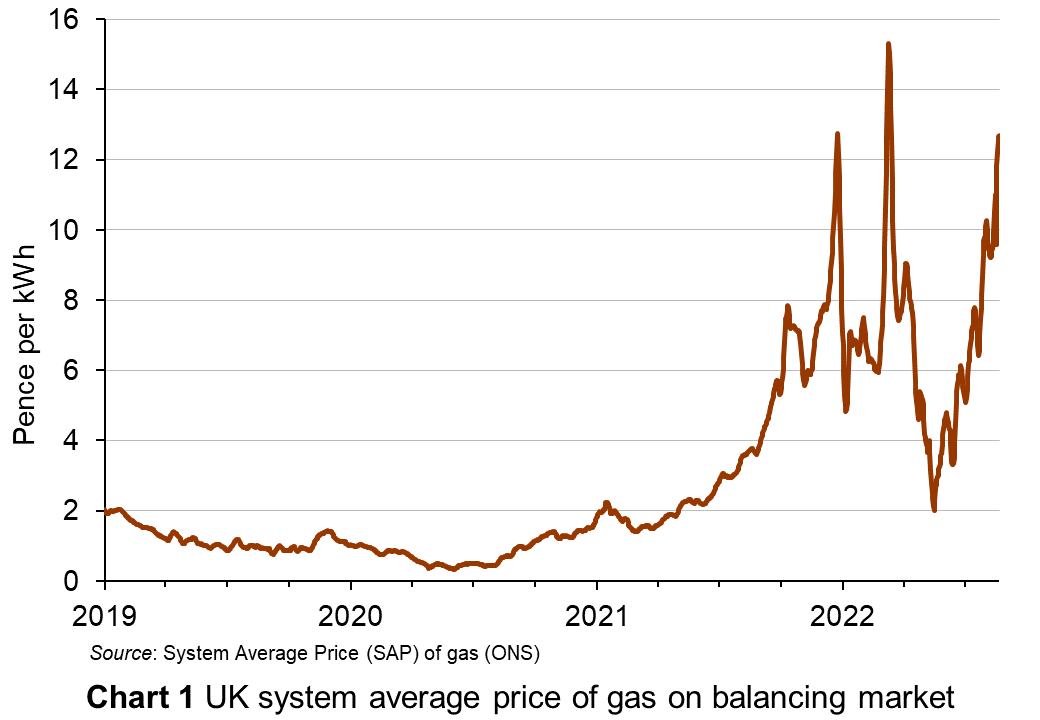 International wholesale gas prices have soared in recent months. This followed a cold winter in 2021/22 across Europe, the bounceback in demand as economies opened up after COVID and, more recently, pressure on supplies since the Russian invasion of Ukraine and the resulting restricted gas supplies from Russia. The price of gas traded on the UK wholesale market is shown in Chart 1 (click here for a PowerPoint). Analysts are forecasting that the wholesale price of gas will continue to rise for some time. The higher price of gas has had a knock-on effect on wholesale electricity prices, as gas-fired power stations are a major source of electricity generation and electricity prices.
International wholesale gas prices have soared in recent months. This followed a cold winter in 2021/22 across Europe, the bounceback in demand as economies opened up after COVID and, more recently, pressure on supplies since the Russian invasion of Ukraine and the resulting restricted gas supplies from Russia. The price of gas traded on the UK wholesale market is shown in Chart 1 (click here for a PowerPoint). Analysts are forecasting that the wholesale price of gas will continue to rise for some time. The higher price of gas has had a knock-on effect on wholesale electricity prices, as gas-fired power stations are a major source of electricity generation and electricity prices.
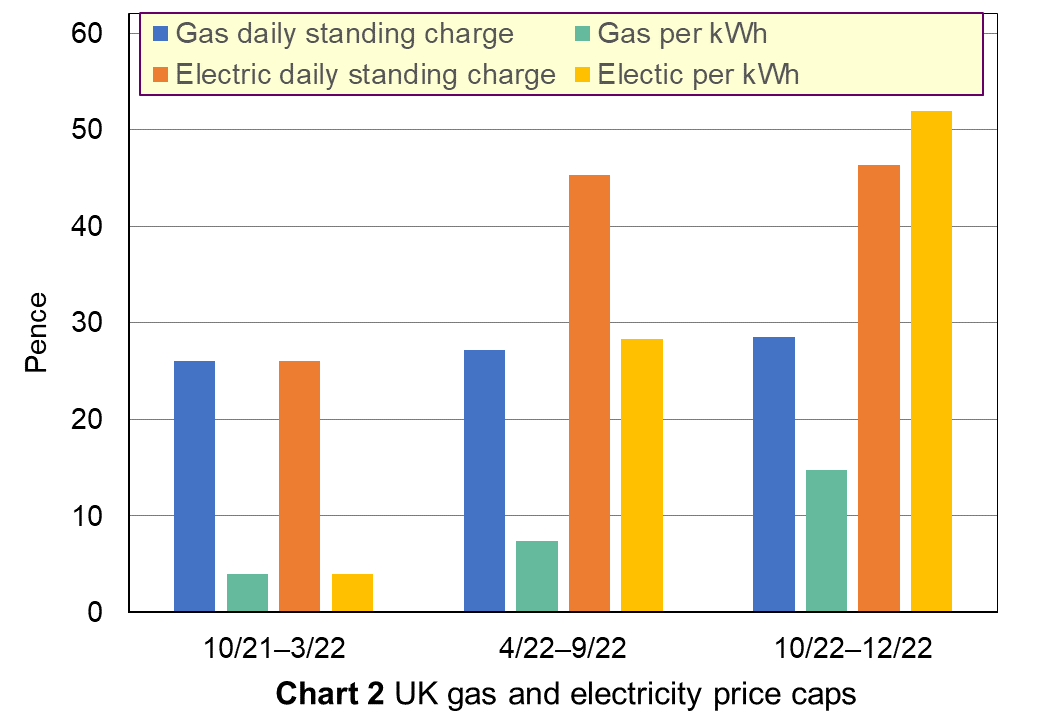 In the UK, domestic fuel prices were capped by the regulator, Ofgem. The cap reflected wholesale prices and was designed to allow electricity suppliers to make reasonable but not excessive profits. The cap was adjusted every six months, but this was been reduced to three months to reflect the rapidly changing situation. Prices are capped for both gas and electricity for both the standing charge and the rate per kilowatt hour (kWh). This is illustrated in Chart 2 (click here for a PowerPoint).
In the UK, domestic fuel prices were capped by the regulator, Ofgem. The cap reflected wholesale prices and was designed to allow electricity suppliers to make reasonable but not excessive profits. The cap was adjusted every six months, but this was been reduced to three months to reflect the rapidly changing situation. Prices are capped for both gas and electricity for both the standing charge and the rate per kilowatt hour (kWh). This is illustrated in Chart 2 (click here for a PowerPoint).
 The effects of the cap were then projected in terms of a total annual bill for a typical household consuming 12 000 kWh of gas and 2900 kWh of electricity. Chart 3 shows the typical fuel bill for the last four price caps and, prior to the mini-Budget of 23 September, the projected price caps for the first and second quarters of 2023 based on forecasts at the time of wholesale prices (click here for a PowerPoint). As you can see, wholesale gas and electricity prices account for an increasing proportion of the total bill. The remaining elements in cost consist of profits (1.9% assumed), VAT (5%), operating costs, grid connection costs and green levies (around £153). The chart shows that, without government support for prices, the price cap would have risen by 80.6% in October 2022 and was projected to rise by a further 51% in January 2023 and by another 23% in March 2023. If this were to have been the case, then prices would have risen by 481% between the summer of 2021 and March 2023.
The effects of the cap were then projected in terms of a total annual bill for a typical household consuming 12 000 kWh of gas and 2900 kWh of electricity. Chart 3 shows the typical fuel bill for the last four price caps and, prior to the mini-Budget of 23 September, the projected price caps for the first and second quarters of 2023 based on forecasts at the time of wholesale prices (click here for a PowerPoint). As you can see, wholesale gas and electricity prices account for an increasing proportion of the total bill. The remaining elements in cost consist of profits (1.9% assumed), VAT (5%), operating costs, grid connection costs and green levies (around £153). The chart shows that, without government support for prices, the price cap would have risen by 80.6% in October 2022 and was projected to rise by a further 51% in January 2023 and by another 23% in March 2023. If this were to have been the case, then prices would have risen by 481% between the summer of 2021 and March 2023.
This was leading to dire warnings of extreme fuel poverty, with huge consequences for people’s health and welfare, which would put extra demands on an already stretched health service. Many small businesses would not be able to survive the extra fuel costs, which would lead to bankruptcies and increased unemployment.
Future wholesale gas prices
 Energy market analysts expect wholesale gas prices to remain high throughout 2023, with little likelihood that gas supplies from Russia will increase. Some European countries, such as Germany, have been buying large amounts of gas to fill storage facilities before winter and before prices rise further. This has added to demand.
Energy market analysts expect wholesale gas prices to remain high throughout 2023, with little likelihood that gas supplies from Russia will increase. Some European countries, such as Germany, have been buying large amounts of gas to fill storage facilities before winter and before prices rise further. This has added to demand.
The UK, however, has only limited storage facilities. Although it is not an importer of gas from Russia and so, in one sense, storage facilities are less important at the current time, wholesale gas prices reflect international demand and supply and thus gas prices in the UK will be directly affected by an overall global shortage of supply.
What would have been the response to the projected rise in gas prices? Eventually demand would fall as substitute fuels are used for electricity generation. But demand is highly inelastic. People cannot readily switch to alternative sources of heating. Most central heating is gas fired. People may reduce consumption of energy by turning down their heating or turning it off altogether, but such reductions are likely to be a much smaller percentage than the rise in price. Thus, despite some use of other fuels and despite people cutting their energy usage, people would still end up spending much more on energy.
Over the longer term, new sources of supply of gas, including liquified natural gas (LNG), may increase supply. And switching to green energy sources for electricity generation, may bring the price of electricity back down and lead to some substitution been gas and electricity in the home and businesses. Also improved home insulation and the installation of heat pumps and solar panels in homes, especially in new builds, may reduce the demand for gas. But these changes take time. Chart 4 illustrates the situation (click here for a PowerPoint).
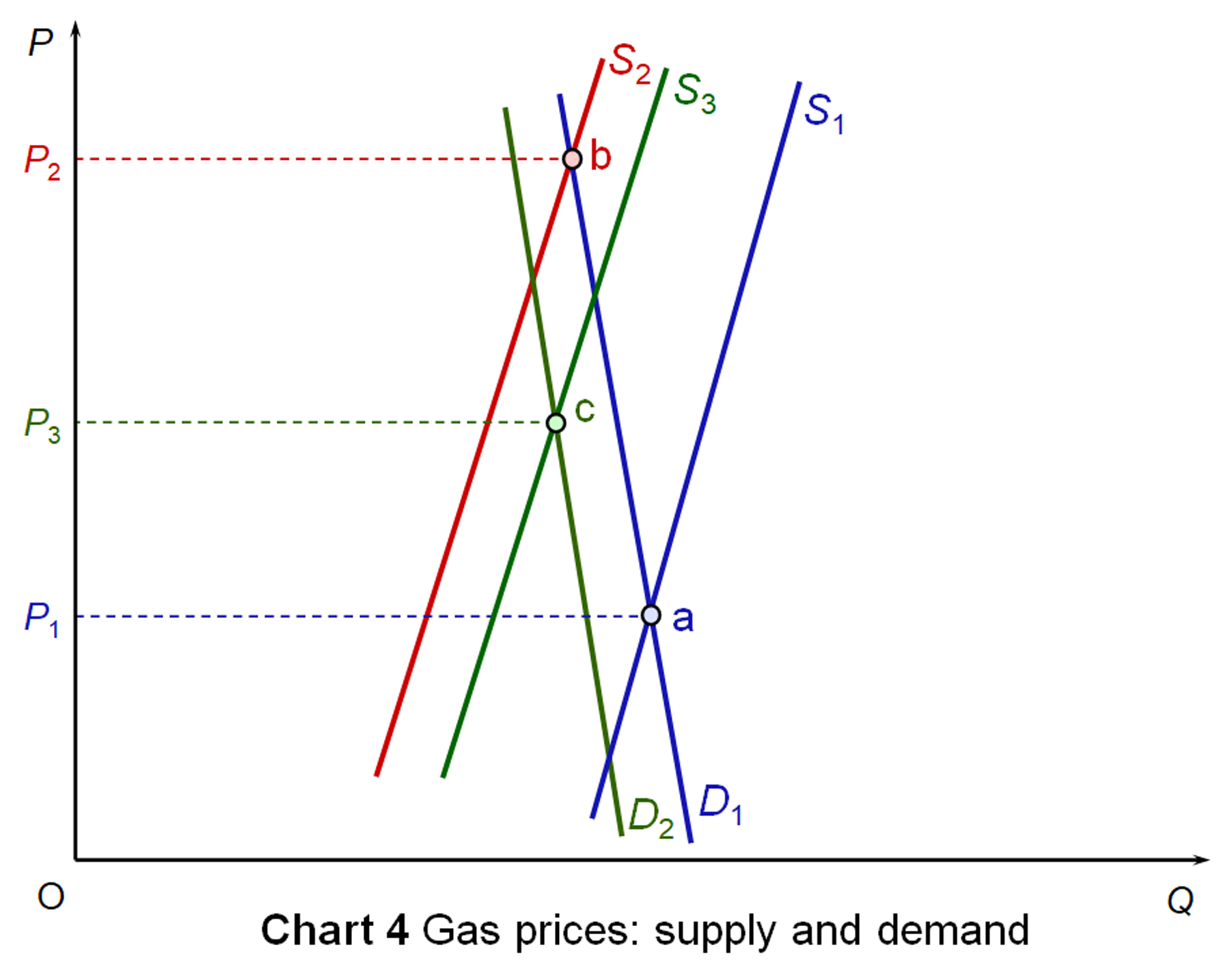 Both demand and supply are relatively inelastic. The initial demand and supply curves are D1 and S1. Equilibrium price is P1 (point a). There is now a fall in supply. Supply shifts to S2. With an inelastic demand, there is a large rise in price to P2 (point b).
Both demand and supply are relatively inelastic. The initial demand and supply curves are D1 and S1. Equilibrium price is P1 (point a). There is now a fall in supply. Supply shifts to S2. With an inelastic demand, there is a large rise in price to P2 (point b).
Over two or three years, there is a modest fall in demand (as described above) to D2 and a modest rise in supply to S3. Price falls back somewhat to P3 (point c). Over a longer period of time, these shifts would be greater and the price would fall further.
Possible policy responses
What could the government do to alleviate the problem? Consensus was that the new Conservative Prime Minister, Liz Truss, and her Chancellor, Kwasi Kwarteng, would have to take radical measures if many households were to avoid severe hardship and debt. One proposal was to reduce VAT on domestic energy from 5% to zero and to cut green levies. Although this would help, it would make only a relatively small dent in people’s rising bills.
 Another proposal was to give people cash payments to help with their bills. The more generous and widespread these payments, the more costly they would be.
Another proposal was to give people cash payments to help with their bills. The more generous and widespread these payments, the more costly they would be.
One solution here would be to impose larger windfall taxes on oil and gas producers (as opposed to retailers). Their profits have soared as oil and gas prices have soared. Such a move is generally resisted by those on the right of politics, arguing that it could discourage investment in energy production. Those on the centre and left of politics argue that the profits are the result of global factors and not because of wise business decisions by the energy producers. A windfall tax would only take away these excess profits.
The EU has agreed a tax on fossil fuel companies’ surplus profits made either this year or next. It is also introducing a levy on the excess revenues that other low-cost power producers make from higher electricity prices.
Another proposal was to freeze retail energy prices at the current or some other level. This would make it impossible for energy suppliers to cover their costs and so they would have to be subsidised. This again would be very expensive and would require substantially increased borrowing at a time when interest rates are rising, or increased taxation at a time when people’s finances are already squeezed by higher inflation. An alternative would be to cap the price North Sea producers receive. As around half of the UK’s gas consumption is from the North Sea, this would help considerably if it could be achieved, but it might be difficult to do so given that the gas is sold onto international markets.
One proposal that was gaining support from energy producers and suppliers is for the government to set up a ‘deficit fund’. Energy suppliers (retailers) would freeze energy prices for two years and take out state-backed loans from banks. These would then be paid back over time by prices being capped sufficiently high to cover costs (which, hopefully, by then would be lower) plus repayments.

Another policy response would be to decouple electricity prices from the wholesale price of gas. This is being urgently considered in the EU, and Ofgem is also consulting on such a measure. This could make wholesale electricity prices reflect the costs of the different means of generation, including wind, solar and nuclear, and would see a fall in wholesale electricity prices. At the moment, generators using these methods are making large profits.
The government’s response
On September 23, the government held a mini-Budget. One of its key elements was a capping of the unit price of energy for both households and firms. The government called this the Energy Price Guarantee. For example, those households on a variable dual-fuel, direct-debit tariff would pay no more than 34.0p/kWh for electricity and 10.3p/kWh for gas. Standing charges are capped at 46p per day for electricity and 28p per day for gas. These rates will apply for 2 years from 1/10/22 and should give an average annual household bill of £2500.
Although the government has widely referred to the ‘£2500 cap’, it is the unit price that is capped, not the annual bill. It is still the case that the more you consume, the more you will pay. As you can see from Chart 3, the average £2500 still represents an average increase per annum of just over £500 per household and is almost double the cap of £1277 a year ago. It will thus still put considerable strain on many household finances.
For businesses, prices will be capped for 6 months from 1 October at 21.1p per kWh for electricity and 7.5p per KWh for gas – considerably lower than for domestic consumers.
The government will pay subsidies to the retail energy companies to allow them to make sufficient, but not excess, profit. These subsidies are estimated to cost around £150 billion. This will be funded by borrowing, not by tax increases, with the government ruling out a windfall tax on North Sea oil and gas extracting companies. Indeed, the mini-Budget contained a number of tax reductions, including scrapping the 45% top rate of income tax, cutting the basic rate of income tax from 20% to 19% and scrapping the planned rise in corporation tax from 19% to 25%.
Articles
Data
Questions
- Why are the demand and supply of gas relatively inelastic with respect to price?
- Why are the long-run elasticities of demand and supply of gas likely to be greater than the short-run elasticities?
- Find out how wholesale electricity prices are determined. Is there a case for reforming the system and, if so, how?
- Identify ways in which people could be protected from rising energy bills.
- Assess these different methods in terms of (a) targeting help to those most in need; (b) economic efficiency.
 In two previous posts, one at the end of 2019 and one in July 2021, we looked at moves around the world to introduce a four-day working week, with no increase in hours on the days worked and no reduction in weekly pay. Firms would gain if increased worker energy and motivation resulted in a gain in output. They would also gain if fewer hours resulted in lower costs.
In two previous posts, one at the end of 2019 and one in July 2021, we looked at moves around the world to introduce a four-day working week, with no increase in hours on the days worked and no reduction in weekly pay. Firms would gain if increased worker energy and motivation resulted in a gain in output. They would also gain if fewer hours resulted in lower costs. Since the financial crisis of 2007–8, the growth in UK productivity has been sluggish. This is illustrated in the chart, which looks at the production industries: i.e. it excludes services, where average productivity growth tends to be slower. (Click here for a PowerPoint of the chart.)
Since the financial crisis of 2007–8, the growth in UK productivity has been sluggish. This is illustrated in the chart, which looks at the production industries: i.e. it excludes services, where average productivity growth tends to be slower. (Click here for a PowerPoint of the chart.)  Productivity in the UK is lower than in many other competitor countries. According to the ONS, output per hour in the UK in 2021 was $59.14 in the UK. This compares with an average of $64.93 for the G7 countries, $66.75 in France, £68.30 in Germany, $74.84 in the USA, $84.46 in Norway and $128.21 in Ireland. It is lower, however, in Italy ($54.59), Canada ($53.97) and Japan ($47.28).
Productivity in the UK is lower than in many other competitor countries. According to the ONS, output per hour in the UK in 2021 was $59.14 in the UK. This compares with an average of $64.93 for the G7 countries, $66.75 in France, £68.30 in Germany, $74.84 in the USA, $84.46 in Norway and $128.21 in Ireland. It is lower, however, in Italy ($54.59), Canada ($53.97) and Japan ($47.28). The model adopted varied across companies, depending on what was seen as most suitable for them. Some gave everyone Friday off; others let staff choose which day to have off; others let staff work 80% of the hours on a flexible basis.
The model adopted varied across companies, depending on what was seen as most suitable for them. Some gave everyone Friday off; others let staff choose which day to have off; others let staff work 80% of the hours on a flexible basis. In its latest
In its latest  But the UK’s lower forecast growth relative to other countries reflects a longer-term problem in the UK and that is the slow rate of productivity growth. This is illustrated in Figure 2, which shows output (GDP) per hour worked in major economies, indexed at 100 in 2008 (click
But the UK’s lower forecast growth relative to other countries reflects a longer-term problem in the UK and that is the slow rate of productivity growth. This is illustrated in Figure 2, which shows output (GDP) per hour worked in major economies, indexed at 100 in 2008 (click  A major cause of low productivity growth is low levels of investment in physical capital. Figure 3 shows investment (gross capital formation) as a percentage of GDP for the G7 countries from the 2007–8 financial crisis to the year before the pandemic (click
A major cause of low productivity growth is low levels of investment in physical capital. Figure 3 shows investment (gross capital formation) as a percentage of GDP for the G7 countries from the 2007–8 financial crisis to the year before the pandemic (click 
 And it is not just physical investment that affects productivity, it is the quality of labour. Although a higher proportion of young people go to university (close to 50%) than in many other countries, the nature of the skills sets acquired may not be particularly relevant to employers.
And it is not just physical investment that affects productivity, it is the quality of labour. Although a higher proportion of young people go to university (close to 50%) than in many other countries, the nature of the skills sets acquired may not be particularly relevant to employers. 
 When building supply and demand models, the assumption is usually made that both producers and consumers act in a ‘rational’ way to achieve the best possible outcomes. As far as producers are concerned, this would mean attempting to maximise profit. As far as consumers are concerned, it would mean attempting to achieve the highest satisfaction (utility) from their limited budget. This involves a cost–benefit calculation, where people weigh up the costs and benefits of allocating their money between different goods and services.
When building supply and demand models, the assumption is usually made that both producers and consumers act in a ‘rational’ way to achieve the best possible outcomes. As far as producers are concerned, this would mean attempting to maximise profit. As far as consumers are concerned, it would mean attempting to achieve the highest satisfaction (utility) from their limited budget. This involves a cost–benefit calculation, where people weigh up the costs and benefits of allocating their money between different goods and services. Black Friday can be seen as a perfect occasion for consumers to get their hands on a bargain. It is an opportunity to fulfil a rational need, for example if you were needing to replace a household appliance but were waiting until there was a good deal before committing to a purchase.
Black Friday can be seen as a perfect occasion for consumers to get their hands on a bargain. It is an opportunity to fulfil a rational need, for example if you were needing to replace a household appliance but were waiting until there was a good deal before committing to a purchase.  Arguably, from a behavioural economist’s perspective, the big problem with Black Friday is that all the reasons consumers possibly have to partake can be largely illusory. Consumers are bombarded with the promise of one-off deals, large discounts, scarce products, and an opportunity to get their holiday shopping done all at once. However, on Black Friday, our rational decision-making faculties are tested, just as stores are trying their hardest to maximise consumers’ mistakes.
Arguably, from a behavioural economist’s perspective, the big problem with Black Friday is that all the reasons consumers possibly have to partake can be largely illusory. Consumers are bombarded with the promise of one-off deals, large discounts, scarce products, and an opportunity to get their holiday shopping done all at once. However, on Black Friday, our rational decision-making faculties are tested, just as stores are trying their hardest to maximise consumers’ mistakes. This year, however, there is also the added complication of the rising cost of living. Whilst this may deter some consumers from unnecessary, impulse purchases, some consumers are using Black Friday as an opportunity to stock up on expected future purchases, hedging against likely price rises over the coming months.
This year, however, there is also the added complication of the rising cost of living. Whilst this may deter some consumers from unnecessary, impulse purchases, some consumers are using Black Friday as an opportunity to stock up on expected future purchases, hedging against likely price rises over the coming months. Black Friday is one of the biggest shopping days of the year. However, the way retailers approach it is growing increasingly mixed. Stores such as Amazon, Argos, Currys and John Lewis have started offering Black Friday deals much earlier in the month, leading some to refer to the event as ‘Black November’. Other stores, such as M&S and Next, didn’t take part at all this year.
Black Friday is one of the biggest shopping days of the year. However, the way retailers approach it is growing increasingly mixed. Stores such as Amazon, Argos, Currys and John Lewis have started offering Black Friday deals much earlier in the month, leading some to refer to the event as ‘Black November’. Other stores, such as M&S and Next, didn’t take part at all this year. In her bid to become Conservative party leader, Liz Truss promised to make achieving faster economic growth her number-one policy objective. This would involve pursuing market-orientated supply-side policies.
In her bid to become Conservative party leader, Liz Truss promised to make achieving faster economic growth her number-one policy objective. This would involve pursuing market-orientated supply-side policies. Theoretically, the argument is simple. If people do work harder and firms do invest more, then potential GDP will rise – a rise in aggregate supply. This can be shown on an aggregate demand and supply diagram. If the policy works, the aggregate supply curve will shift to the right. Real GDP will rise and there will be downward pressure on prices. In Figure 1, real GDP will rise from Y0 to Y1 and the price level will fall from P0 to P1. However, things are not as simple as this. Indeed, there are two major problems.
Theoretically, the argument is simple. If people do work harder and firms do invest more, then potential GDP will rise – a rise in aggregate supply. This can be shown on an aggregate demand and supply diagram. If the policy works, the aggregate supply curve will shift to the right. Real GDP will rise and there will be downward pressure on prices. In Figure 1, real GDP will rise from Y0 to Y1 and the price level will fall from P0 to P1. However, things are not as simple as this. Indeed, there are two major problems. If top rates of income tax are already at a very high level, then cutting then may well encourage more work. After all, there is little incentive to work more if the current rate of tax is over 90%, say. Cutting them to 80% could have a big effect. This was the point made by Art Laffer, one of Ronald Reagan’s advisors. He presented his arguments in terms of the now famous ‘Laffer curve’, shown in Figure 2. This shows the total tax revenue raised at different tax rates.
If top rates of income tax are already at a very high level, then cutting then may well encourage more work. After all, there is little incentive to work more if the current rate of tax is over 90%, say. Cutting them to 80% could have a big effect. This was the point made by Art Laffer, one of Ronald Reagan’s advisors. He presented his arguments in terms of the now famous ‘Laffer curve’, shown in Figure 2. This shows the total tax revenue raised at different tax rates. Cutting taxes and financing them from borrowing will expand aggregate demand. In Figure 1, the AD curve will also shift to the right and this will push up prices. Inflation is already a serious problem in the economy and unfunded tax cuts will make it worse. Higher inflation will result in the Bank of England raising interest rates further to curb aggregate demand. But higher interest rates, by raising borrowing costs, are likely to reduce investment, which will have a negative supply-side effect.
Cutting taxes and financing them from borrowing will expand aggregate demand. In Figure 1, the AD curve will also shift to the right and this will push up prices. Inflation is already a serious problem in the economy and unfunded tax cuts will make it worse. Higher inflation will result in the Bank of England raising interest rates further to curb aggregate demand. But higher interest rates, by raising borrowing costs, are likely to reduce investment, which will have a negative supply-side effect. Those advocating market-orientated supply-side policies argue that, by making GDP bigger, everyone can gain. They prefer to focus on the size of the national ‘pie’ rather than its distribution. If the rich initially gain, the benefits will trickle down to the poorest in society. This trickle-down theory was popular in the 1980s with politicians such as Margaret Thatcher and Ronald Reagan and, more recently, with Republican presidents, such as Goerge W Bush and Donald Trump. There are two problems with this, however.
Those advocating market-orientated supply-side policies argue that, by making GDP bigger, everyone can gain. They prefer to focus on the size of the national ‘pie’ rather than its distribution. If the rich initially gain, the benefits will trickle down to the poorest in society. This trickle-down theory was popular in the 1980s with politicians such as Margaret Thatcher and Ronald Reagan and, more recently, with Republican presidents, such as Goerge W Bush and Donald Trump. There are two problems with this, however. International wholesale gas prices have soared in recent months. This followed a cold winter in 2021/22 across Europe, the bounceback in demand as economies opened up after COVID and, more recently, pressure on supplies since the Russian invasion of Ukraine and the resulting restricted gas supplies from Russia. The price of gas traded on the UK wholesale market is shown in Chart 1 (click
International wholesale gas prices have soared in recent months. This followed a cold winter in 2021/22 across Europe, the bounceback in demand as economies opened up after COVID and, more recently, pressure on supplies since the Russian invasion of Ukraine and the resulting restricted gas supplies from Russia. The price of gas traded on the UK wholesale market is shown in Chart 1 (click  In the UK, domestic fuel prices were capped by the regulator, Ofgem. The cap reflected wholesale prices and was designed to allow electricity suppliers to make reasonable but not excessive profits. The cap was adjusted every six months, but this was been reduced to three months to reflect the rapidly changing situation. Prices are capped for both gas and electricity for both the standing charge and the rate per kilowatt hour (kWh). This is illustrated in Chart 2 (click
In the UK, domestic fuel prices were capped by the regulator, Ofgem. The cap reflected wholesale prices and was designed to allow electricity suppliers to make reasonable but not excessive profits. The cap was adjusted every six months, but this was been reduced to three months to reflect the rapidly changing situation. Prices are capped for both gas and electricity for both the standing charge and the rate per kilowatt hour (kWh). This is illustrated in Chart 2 (click  The effects of the cap were then projected in terms of a total annual bill for a typical household consuming 12 000 kWh of gas and 2900 kWh of electricity. Chart 3 shows the typical fuel bill for the last four price caps and, prior to the mini-Budget of 23 September, the projected price caps for the first and second quarters of 2023 based on forecasts at the time of wholesale prices (click
The effects of the cap were then projected in terms of a total annual bill for a typical household consuming 12 000 kWh of gas and 2900 kWh of electricity. Chart 3 shows the typical fuel bill for the last four price caps and, prior to the mini-Budget of 23 September, the projected price caps for the first and second quarters of 2023 based on forecasts at the time of wholesale prices (click  Energy market analysts expect wholesale gas prices to remain high throughout 2023, with little likelihood that gas supplies from Russia will increase. Some European countries, such as Germany, have been buying large amounts of gas to fill storage facilities before winter and before prices rise further. This has added to demand.
Energy market analysts expect wholesale gas prices to remain high throughout 2023, with little likelihood that gas supplies from Russia will increase. Some European countries, such as Germany, have been buying large amounts of gas to fill storage facilities before winter and before prices rise further. This has added to demand.  Both demand and supply are relatively inelastic. The initial demand and supply curves are D1 and S1. Equilibrium price is P1 (point a). There is now a fall in supply. Supply shifts to S2. With an inelastic demand, there is a large rise in price to P2 (point b).
Both demand and supply are relatively inelastic. The initial demand and supply curves are D1 and S1. Equilibrium price is P1 (point a). There is now a fall in supply. Supply shifts to S2. With an inelastic demand, there is a large rise in price to P2 (point b). 